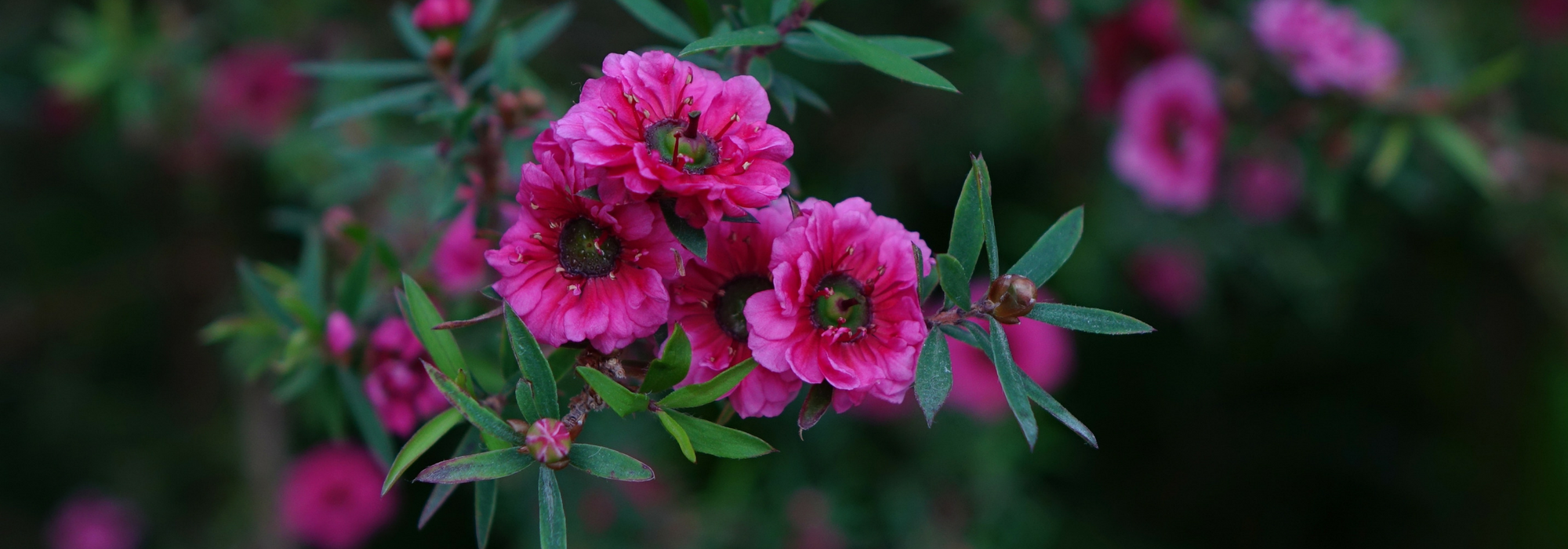
Tea tree, Leptospermum: planting, pruning and care
Contents
Tea Tree, Leptospermum in a nutshell
- Leptospermum are very decorative evergreen bushes in spring and sometimes even in the heart of winter.
- Their small silver leaves highlight a profusion of small melliferous and slightly fragrant flowers.
- The flowering with single or double flowers declinates from pale pink, white to crimson red, sometimes bicoloured.
- They prefer light, rather poor and well-drained soils, of acidic to slightly calcareous nature and a sunny exposure.
- They have quite low hardiness but tolerate sea spray, drought as well as pollution.
A word from our expert
Leptospermum, or tea tree, are upright and bushy young plants with small evergreen leaves that are often aromatic, providing a long flowering period that can extend from March to July depending on the varieties. They are quite accommodating in terms of soil, moderately hardy (-5 to -10°C depending on the varieties) and primarily grow in regions with mild winters.
Many cultivars exist, offering very long, brightly coloured flowerings in pink, red, white, or even salmon. Among the best are Leptospermum ‘Martini’, spectacular and flowering from April to June, ‘Red Damask’, with bright pink double flowers, and Leptospermum Blanc, a vigorous bush with single white flowers. In their country of origin, Leptospermum are used in large hedges or as background plants.
Here, these floriferous and low-maintenance bushes are popular in gardens with mild climates. They often serve as one of the centrepieces of a small garden, in a shrub border alongside ericaceous plants. The combination is ideal with other plants from southern regions belonging to the same Myrtaceae family (Melaleuca, Callistemon, Feijoa, Eucalyptus) or Proteaceae such as Grevillea, or alongside Echium pininana or fastuosum, Beschorneria yuccoides, Melianthus, and Euryops with its endless yellow flowering. Gardeners in more continental climates will grow them easily in large pots on the terrace, to be stored away in winter.
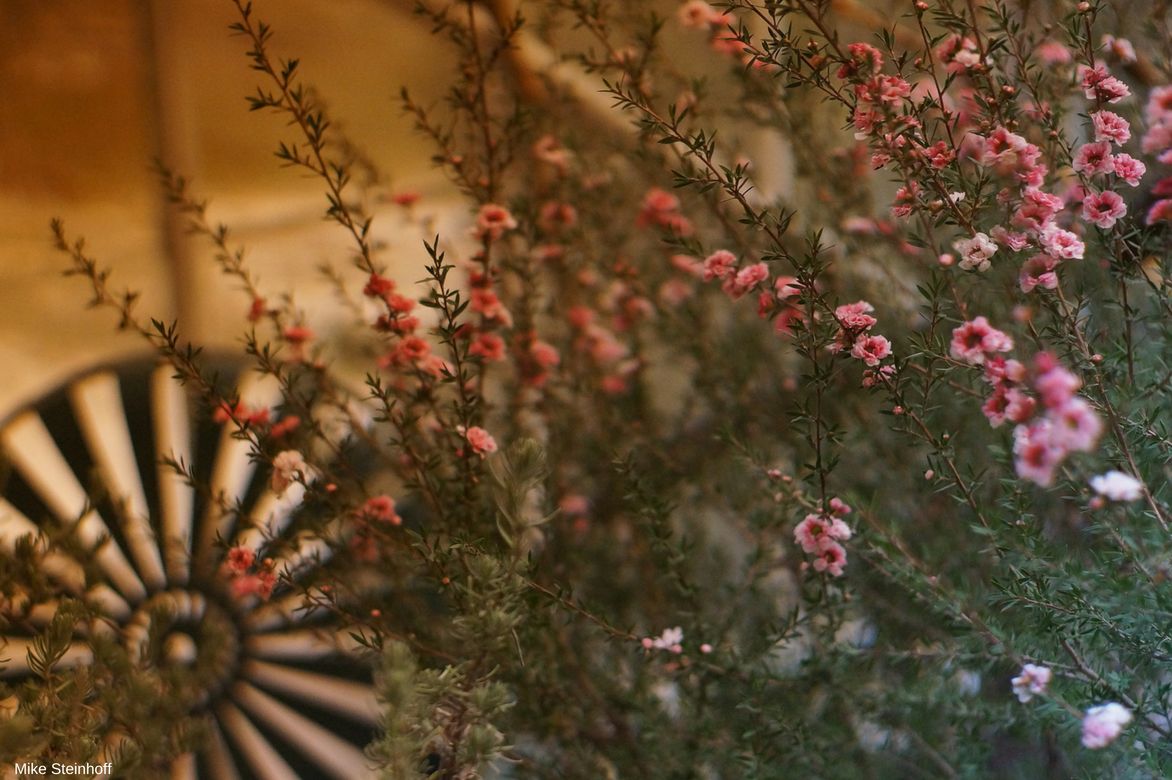
Beautiful flowering of the tea tree.
The tea tree is content with a light, moist to dry, and often poor soil. Beyond its truly charming flowering, the delicacy of its evergreen leaves, and its robustness against diseases, its qualities lie in its tolerance to wind, drought, pollution, and sea spray. An ideal plant for coastal regions that requires no maintenance.
As a little history, Leptospermum gets its common name of tea tree (not to be confused with the “Tea-tree” used in aromatherapy) from Captain Cook and his crew who brewed the leaves of Leptospermum scoparium among others, as a preventive measure against scurvy and to aid digestion.
Description and Botany
Botanical data
- Latin name Leptospermum sp.
- Family Myrtaceae
- Common name New Zealand myrtle, Tea tree, Manuka
- Flowering between April and June mainly
- Height between 30 cm and 2 m
- Sun exposure sun
- Soil type light, drained, rather poor and acidic soils
- Hardiness medium to low
Tea tree, Leptospermum or False myrtles, sometimes referred to as New Zealand myrtle, Australian myrtle or locally Manuka are evergreen bushes from the Myrtaceae family. Other shrubs commonly called myrtle, featuring aromatic foliage and belonging to the same family include the genera Myrtus, found in the Mediterranean scrubland, Luma, from the temperate forests of Brazil and Argentina, and finally Eugenia, whose most well-known species E. uniflora refers to the cherry of the Antilles, also known as “Australian myrtle”. Despite its name tea tree, the famous essential oil of Tea tree comes from another Australian Myrtaceae, Melaleuca alternifolia. The oil from Leptospermum scoparium is known as Manuka essential oil, knowing that Leptospermum petersonii (syn. citratum) is also used in aromatherapy.
The genus Leptospermum comprises nearly 86 species, most of which are native to South-Eastern Australia (83 including 2 endemic), the mountains of the Indonesian archipelago (Malaysia, Borneo…) and only one or two from New Zealand, contrary to what their common name suggests. Many cultivars have emerged from New Zealand nurseries but also from American, Irish, and British nurseries due to spontaneous sowing. The species Leptospermum scoparium is the one chosen by horticulturists for the selection of cultivars due to its low level of requirements. It is found throughout New Zealand as well as in the far South-Eastern Australia from the coast where it reaches 8 m in height, to the mountains where it forms compact cushions. It is most often found on wet lands or temporarily waterlogged areas, as well as near geysers where the soil is warm and on acidic, nutrient-poor soils. This evergreen shrub populates the matorral consisting of heathland and scrub regularly burned, typical of the Australian landscape. When no fire has occurred for over 50 years, it is replaced by forest which leaves no chance for manukas, even the older ones, forced to disappear without leaving any descendants. The passage of fire is essential to trigger the opening of the capsules and the dissemination of its fine elongated seeds. They will germinate in a sunny spot enriched by ashes.
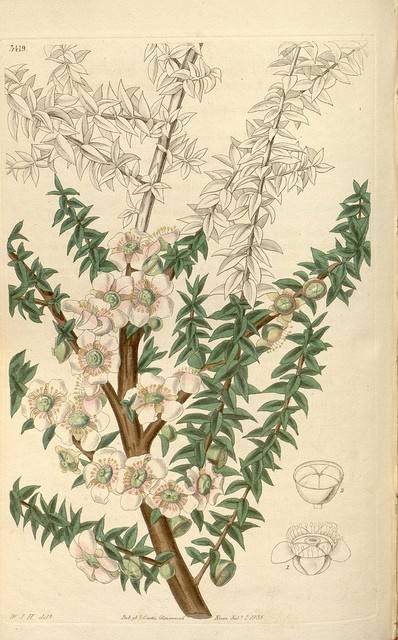
Leptospermum scoparium – botanical illustration
The tea tree typically has an erect habit reaching 2-3 m in height, but rather rounded, compact and bushy, about 1 to 2 m, in cultivated forms. Dwarf forms of 30 cm ideal for pots or rockeries have recently appeared. Growth is slow to rapid depending on the cultivars, and the shrub accepts light pruning after flowering. The vertical branches bear small aromatic leaves, alternate, simple and evergreen. The elongated lamina, dark green with varying shades of bronze and purple, sometimes villous and silver like in Leptospermum lanigerum, has a short needle-like appearance, sometimes prickly. The foliage is rich in essential oils like most Myrtaceae (Eucalyptus…). The light bark becomes hard and fissured on older specimens.
The flowers with 5 distinct round petals, generally white or pink in colour, feature a large dark centre adorned with numerous short stamens fused to the corolla in groups of 5 and a pistil. The 5 sepals usually fall off at the time of blooming. Here, flowering occurs between April and June but it is not uncommon to see it begin in winter when the climate is particularly mild and sunny and to continue into summer. The flowering that adorns almost all the branches is aromatic and very melliferous, but diffuses rather little fragrance. The cultivars with double flowers have the appearance of small crumpled pom-poms with a truly unique dark centre. ‘Pink Damask’ is one of the most cold-resistant. The small diameter of the corollas, ranging from 1 to 3 cm, is compensated by the profusion of flowers that persist for a long time on the branches and are highlighted by generally dark foliage. The colour range extends from white to crimson, including bicoloured pink and white forms.
The flowers are followed by capsules that contain fine elongated seeds as indicated by the Latin etymology of the name Lepto-spermum “thin seed”. The capsules only release the seeds after the passage of fire so you can heat them with a lighter to force them to open and collect the seeds.
The foliage of Leptospermum provides a tea rich in vitamin C. Simply pick small twigs between April and October and steep them a little longer than for real tea, either fresh or dried. The essence is also valued in floristry.

Flowers of the tea tree, single or double: Leptospermum scoparium ‘White’ (Photo B. Gratwicke), Leptospermum scoparium ‘Martini’, Leptospermum scoparium ‘Red Damask’ (Photo Sid Mosdell).
Read also
Abutilon : plant, pruning, maintainThe main varieties of Leptospermum
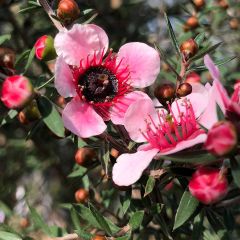
Leptospermum scoparium Martini - Tea-tree
- Flowering time June to August
- Height at maturity 1,50 m
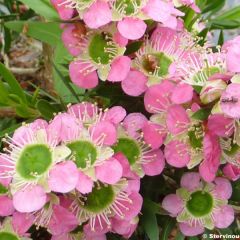
Leptospermum Karo Pearl Star - Tea-tree
- Flowering time June to August
- Height at maturity 1,50 m
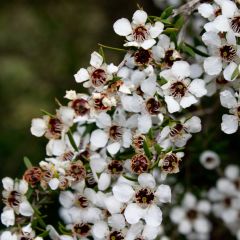
Leptospermum scoparium White - Tea-tree
- Flowering time June to August
- Height at maturity 3 m
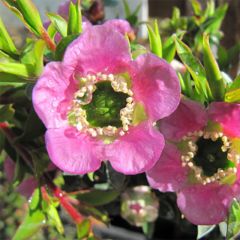
Leptospermum Karo Spectro Bay - Tea-tree
- Flowering time June to August
- Height at maturity 2 m
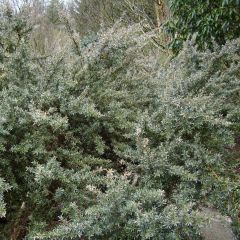
Leptospermum lanigerum Silver Sheen - Woolly Tea-tree
- Flowering time June to August
- Height at maturity 1,70 m
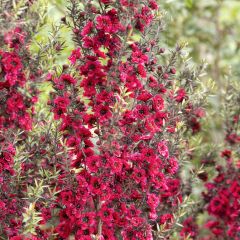
Leptospermum scoparium Red damask - Tea-tree
- Flowering time June to August
- Height at maturity 1,30 m
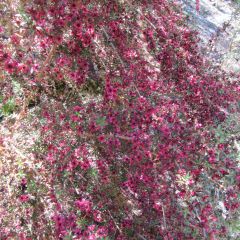
Leptospermum scoparium Jubilee - Tea-tree
- Flowering time June to August
- Height at maturity 1,25 m
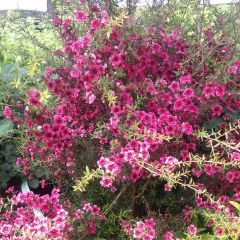
Leptospermum scoparium Wiri Kerry - Tea-tree
- Flowering time June to August
- Height at maturity 90 cm
Discover other Leptospermum
View all →Available in 1 sizes
Available in 1 sizes
Available in 1 sizes
Available in 1 sizes
Available in 2 sizes
Available in 1 sizes
Available in 1 sizes
Available in 1 sizes
Available in 1 sizes
Available in 1 sizes
Planting Leptospermum
Where to plant the tea tree?
The tea tree grows naturally in regions with a mild and fairly humid oceanic climate, but also in dry forests, most often on mineral-poor soil, leached, neutral to acidic. However, some authors who specialise in Mediterranean plants confirm their tolerance to slightly calcareous soils, provided they are light, loamy, and well-drained.
Leptospermum are quite frost-sensitive, with hardiness varying from -5 to -12°C. The clump can resprout from the stump when the aerial part succumbs to the cold. The Australian montane species Leptospermum lanigerum is one of the most frost-resistant, although its aerial part can be affected from -8°C. It enjoys sunlight but not overly hot situations; plant it preferably in a seaside garden or in partial shade if sunlight is intense. L. scoparium ‘Red Damask’ is also known for its robustness.
Plant Leptospermum in the ground without fear on slightly calcareous soil from the Mediterranean and Atlantic coasts, from the Basque Country to Normandy. The soil should be light, sandy or humus-bearing and fairly well-drained if frost is a concern. However, it accepts wet soils permanently or temporarily in a mild climate.
Old specimens tolerate drought, sea spray, and pollution very well. Container cultivation is not a barrier, allowing continental gardeners to enjoy their generous flowering throughout the beautiful season.
When to plant?
Although it is possible to plant potted Leptospermum at any time of the year, ideally, it is best to do so in spring to ensure good root anchorage before winter arrives. Avoid intervening during frost, extreme heat, or when they are flowering.
How to plant the tea tree?
Leptospermum, depending on its habit, can form medium evergreen hedges, create a border alongside Ceanothus, bushy Veronica, or Cistus, or even edgings with dwarf varieties. A dry, sunny rockery can also accommodate the tea tree.
- Soak the root ball in a bucket of water to thoroughly moisten it.
- Dig a planting hole three times the diameter of the root ball.
- Add manure or decomposed compost, or even blonde peat to lower the pH.
- Place the plant in the planting hole.
- Replace the soil and lightly firm it down.
- Water.
The recovery is easy and quick and requires little maintenance.
For container cultivation, place a drainage layer of 3-4 cm at the bottom of the pot (gravel, broken pottery, etc.). Add a mix consisting of 3/4 potting soil (rich in blonde peat) and 1/3 coarse sand.
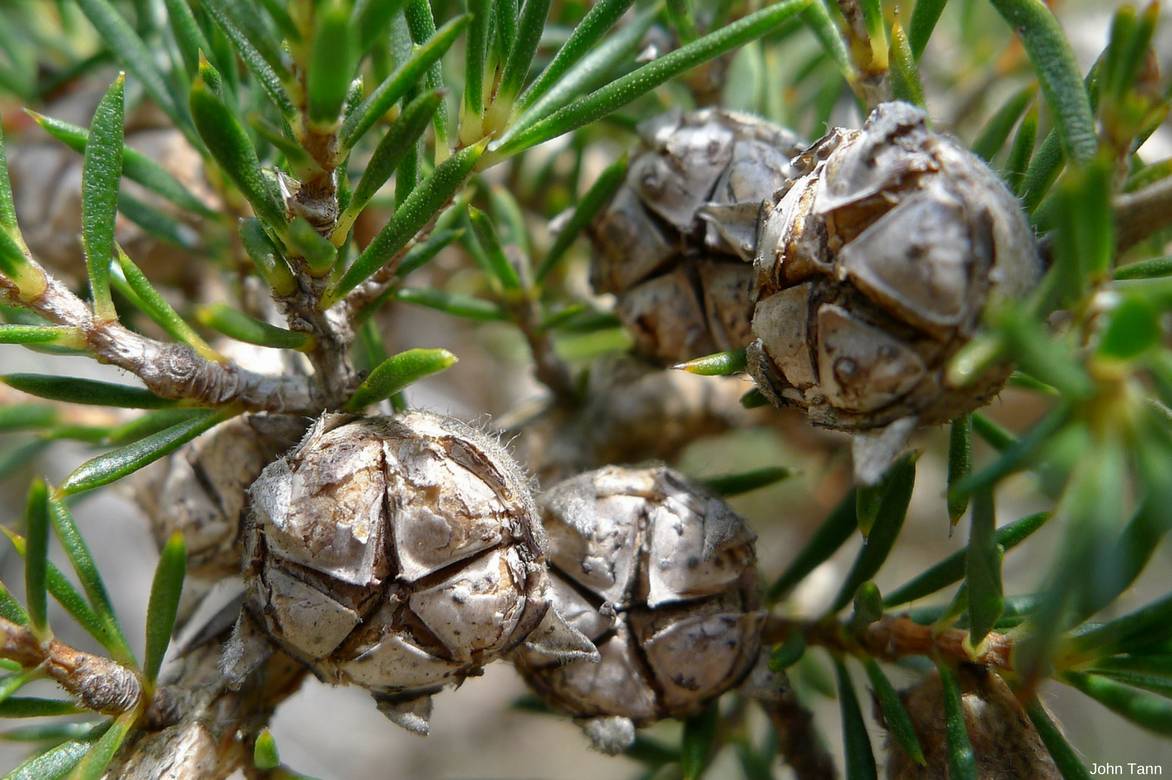
Fruits of Leptospermum.
Maintenance and pruning
Renew the application of compost or manure every year in spring or from autumn, especially on potted plants; otherwise, the bush is quite undemanding and requires no care in open ground.
After flowering between May and July, carry out a balancing pruning if necessary by cutting back only a third of the leafy shoot. Compact forms have a rather slow growth, making it rare to need intervention.
Bring the potted plant into a bright cold greenhouse from November. The temperature should not exceed 10°C. Topdress the pot with compost in May, when taking the plant outside. Do not allow water to stagnate in the saucer. → Read: How to winter the Leptospermum.
Leptospermum is known for its hardiness against diseases and pests. It is sometimes attacked by scale insects, which cause the foliage to blacken due to a fungus called sooty mould. Apply a white oil at the beginning of spring.
Multiplication: propagation by cuttings and layering
Propagation by cuttings and layering are the most commonly used methods to multiply Leptospermum.
Propagation by Cuttings
The tea tree can be propagated from July to September.
Prepare a pot deep by filling it halfway with potting soil mixed with sand.
- Take a cutting about ten centimetres long from a shoot of the year.
- Remove the leaves from the lower two-thirds of the cutting.
- Insert the cuttings into the substrate up to the level of the first leaves and thoroughly soak the entire pot.
- Place the culture under a frame or in a cold greenhouse during the winter from November to May. Always keep the substrate moist but not overly wet.
- Proceed step by step when taking the pots outside into the garden.
- Wait another year before placing the young plants in the ground.
Layering
This method is simpler than propagation by cuttings but has the disadvantage of producing fewer new plants. Proceed in July after flowering.
- Lay a long, flexible shoot down towards the ground so that its central part is buried.
- Scratch the bark with your nail or a grafting knife to facilitate root penetration, then hold this portion of the shoot in the soil with a hook.
- Place a small stake to straighten the end of the layering that emerges from the ground to about 10 cm in height.
- Wait at least a year before separating the layering from its mother plant with a pruning shear.
- Grow it for 6 months in a pot before planting it in its final place.
→ Learn more about the propagation of Leptospermum with Olivier in our tutorial!
Usage and Association in the Garden
Leptospermum form dense and compact bushes that can be used to create effective windbreak hedges in coastal gardens, particularly with L. lanigerum ‘Silver Sheen’ which has a rapid growth rate of up to 2 m tall. They are suitable for forming medium evergreen hedges (no more than 2 m) alongside Myrtles, large rockroses (Cistus laurifolius, Cistus (x) aguilari), Feijoa, Olearia, and Tasmanian Pepper (Drimys aromatica), as well as spring Ceanothus…
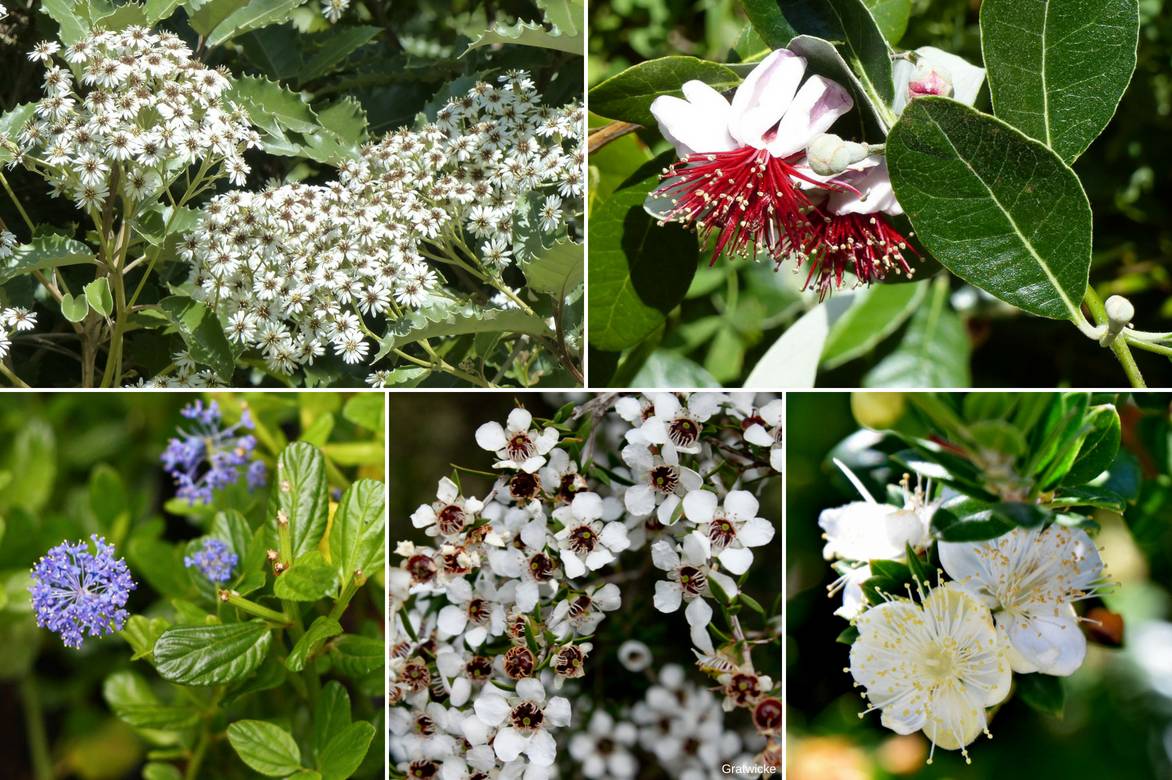
An example of association for coastal areas: Olearia virgata, Acca sellowiana ‘Coolidge’, Ceanothus impressus ‘Victoria’, Leptospermum scoparium ‘White’, Myrtus communis ‘Tarantina’.
You can combine them with other Australian or New Zealand shrubs such as Callistemon (bottlebrush), Grevillea, Melaleuca, but also with South African species that will create an uncommon exotic scene like Gomphostigma White Candy resembling silver broom, the graceful Dierama known as angel’s fishing rods with their pink or white bells swaying in the wind. Aloe arborescens, Anisodontea capensis, Echium fastuosum, Beschorneria, or Melianthus major should thrive in similar growing conditions.
Leptospermum are also excellent subjects for creating a heather soil border alongside woodland Camellias, tree heathers, azaleas, rhododendrons, and a Japanese maple.
Low varieties like Wiri Kerry can accompany in a rockery or a hedge under one metre tall with Tarentine Myrtle, spreading rockroses like Cistus purpureus, Cistus (x) argenteus, compact Ceanothus, and Myrsine africana…
→ Discover more ideas for associating with Leptospermum in our advice sheet!
Did you know?
The Maoris made tea from the foliage of Manuka as the plant is rich in vitamin C, which explains the interest of James Cook’s sailors who took this plant on board to combat scurvy during the second voyage. On board were the botanists Johann Reinhold Forster and his son Johann Georg Adam Forster, who introduced the species Leptospermum scoparium in 1776. The genus was described almost a century later by another Briton, George Bentham, in 1866 in his work Flora Australiensis through the study of 20 species, acknowledging the great difficulties he had in distinguishing them.
The distillation of the leaves with steam allows for the extraction of Manuka essential oil or New Zealand Tea tree, highly valued for its antiseptic, antibiotic, antiviral, antifungal, anti-inflammatory, antihistaminic, analgesic, and anti-allergic properties.
To go further
Discover our wide range of Leptospermum
Our advice sheet: Leptospermum, the most beautiful varieties
- Subscribe!
- Contents
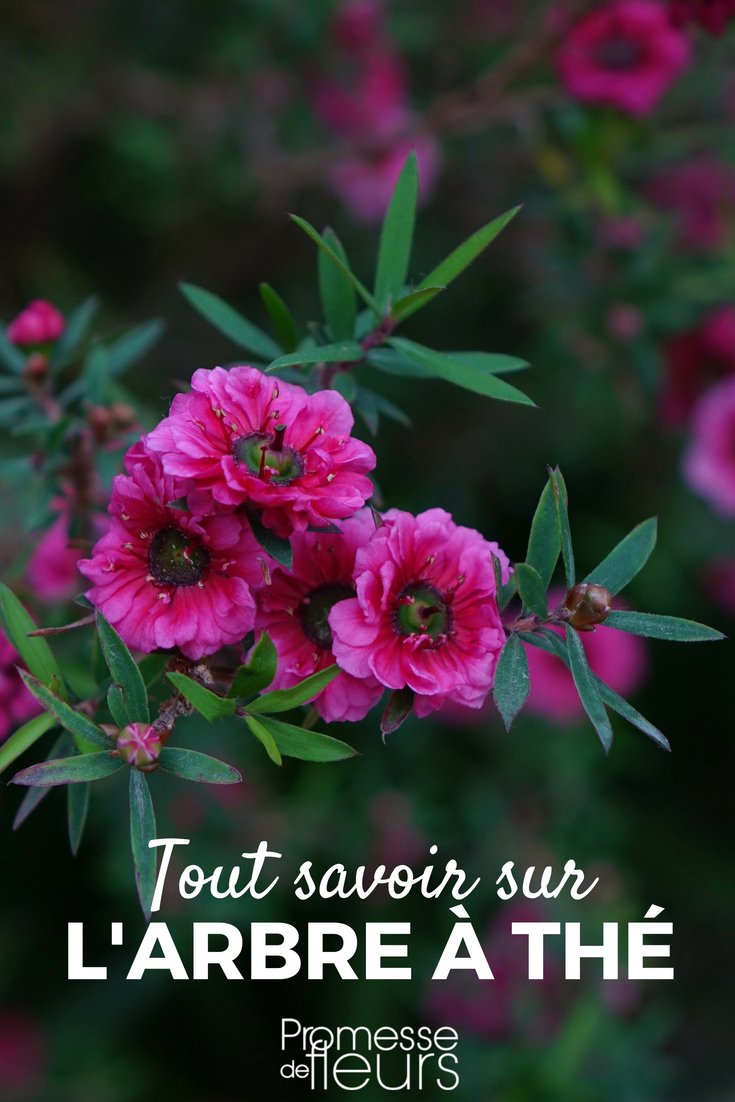































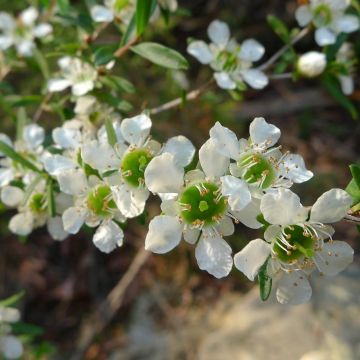


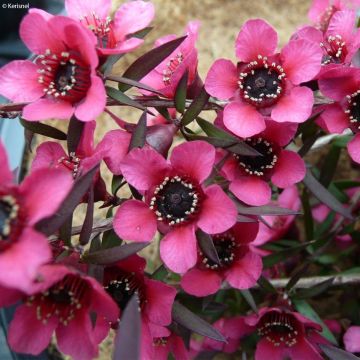

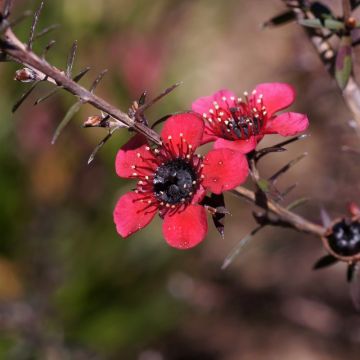
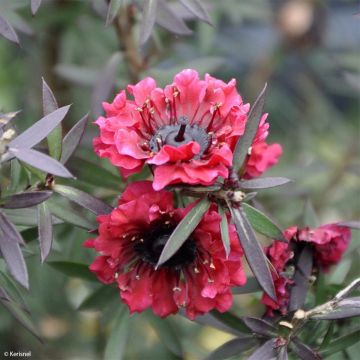
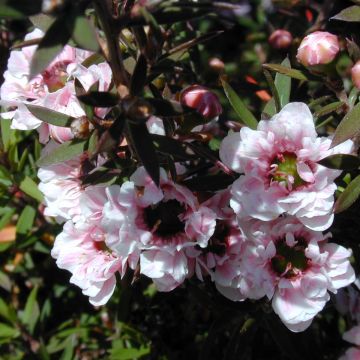


Comments